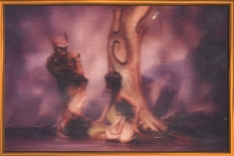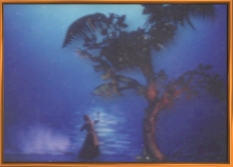

GROUP PRODUCTIONS
JUNGLE BOOK - THE ADVENTURES OF MOWGLI (1984) (Collaboration)
The Adventures of Mowgli, intended for audiences of every cultural background, is an action-packed dance story based on Rudyard Kipling’s magical book titled Jungle Book, a story rich in adventure, color, drama and pure fun. This charming Indian jungle story retold in dance and mime was choreographed by Dhananjayan for the Academy of Indian Dance in London. It has the distinction of being the first production presented by the Academy.Premiered in London on March 17, 1984, the story of Mowgli was choreographed on artists based in Britain. It incorporated different styles such as Bharatanaatyam, Odissi, Kathakali, Kathak and free form that went down so well with the British audience, that it was staged for 3 seasons in England over 3 years, in 1984, 85 and 86. At a stretch 80 shows were presented and later on, in 2 seasons. Jungle Book has been presented nearly 150 times, in mainstream theatres in UK.
In terms of foresight, the production eschewed grand mythological, religious and historical themes. The general perception of Europeans and people connected with Indology and Indian art was that Bharatanaatyam was a solo dance and could not be used effectively to make theatrical productions. Indian in content, classical in execution, Jungle Book was a presentation with innovative and creative movements deployed to bring in the beauty of Nature. It was a trendsetter because it gave other people also the enthusiasm to break away from tradition and adapt novel themes. Some of the participating dancers from this production made good of their experience and broke into new pastures.
The composer and choreographers transcended stylistic boundaries, joining and blending the styles in a way as to preserve the clarity and brilliance of the classical and yet introduce freedom of modern expression.
The choreography was done first. After that, Pt. Vijayaraghava Rao scored the music. A large-scale pre-recorded score using traditional Indian and western instruments and a synthesizer was created minus lyrics. Words were eliminated to make the production more universal and give emphasis to the music, which gave expression to the whole delineation.
Lots of new movements for animals were introduced because, except for 3 humans, the rest were animal characters. The Natya Sastra describes movements to depict animals and birds. New movements in dance were used to create character identities to suit the animal parts, with some of the classical adavus interspersed here and there. Dhananjayan had to invent a wolf characterization since the animal does not feature in classical dance. For the strides of the panther, steps were borrowed from a folk theatre. In short, The Adventures of Mowgli demanded the skills of an actor.
The simple décor consisted of an exotic tree with movable branches, designed by Jan Blake, which changed its colors and shape for different scenes and different seasons. The whole story moved around the tree. The costumes were Indian with appropriate decorations or additions to suggest the animal characters.
Director / choreographer: V P Dhananjayan, Music: Pt. Vijayaraghava Rao,
Artistic Advisor: Pt. Ravi Shankar, Kathak choreographer: Pratap Pawar,
Costumes: Shanta Dhananjayan
Synopsis
In the forests of India, a long, long time ago, lived a boy raised by a kindhearted mother wolf and taught the ways of the jungle by an old bear named Baloo. He was happy with his animal friends, living amongst the trees and flowers, with but a single enemy, the tiger Sher Khan. One day, he happened to meet Sita…
This story of love, evil and adventure, the colorful characters like the panther Bhageera, the snake Ka, the wolves, the monkeys and so on, has a universal appeal to the young as well as the old. The message is, if animals can do noble deeds in certain situations, why not humans and this became the elevating factor in the show.
"Jungle Book gave European audiences the idea of how Indian classical dance can be exploited to make theatrical productions. It was quite a challenge...this collaborative venture was an achievement in enterprise and effort, but then creating Jungle Book in a classical dance form by itself was a challenge."
"Our student Pushkala Gopal was then the director of Academy of Indian dance. That was the time people wanted something new, to break away from the normal. Pushkala asked us to do one such production. After meetings with the Arts Council, we decided to use the 4 Indian classical dance styles and choreograph a dance drama based on Jungle Book, which had just been released as an animated film. Though Indian in subject, it was different from the usual Krishna or Rama stories."
"Some of the artists who participated in Jungle Book have now become artists of international stature. I portrayed the older Mowgli, my son Satyajit did the role of little Mowgli. Akram Khan who was about 7 then, was selected in an audition to be the other little Mowgli since there was a law in UK that a child could not do more than 2 shows a week. Akram did so well and when he got good reviews in the press, his parents admitted him into Pratap Pawar’s dance school. He’s now a famous Kathak dancer and also doing contemporary work."
"The characters had to be chosen carefully to retain the classical content yet bring in animals in a novel way into the Bharatanaatyam repertoire."
"After we did the choreography, Pt. Vijayaraghava Rao scored the music; he’s such a wonderful musician. We call it fusion music without confusion! We worked for a month on the music before recording it in a Madras studio."
JUNGLE BOOK – THE ADVENTURES OF MOWGLI (1984) - Reviews - Photo Album
